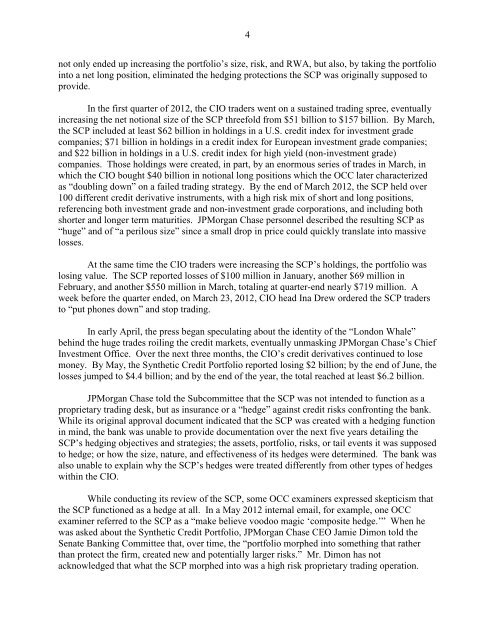JPMORGAN CHASE WHALE TRADES: A CASE HISTORY OF DERIVATIVES RISKS AND ABUSES
JPMORGAN CHASE WHALE TRADES: A CASE HISTORY OF DERIVATIVES RISKS AND ABUSES
JPMORGAN CHASE WHALE TRADES: A CASE HISTORY OF DERIVATIVES RISKS AND ABUSES
Create successful ePaper yourself
Turn your PDF publications into a flip-book with our unique Google optimized e-Paper software.
4<br />
not only ended up increasing the portfolio’s size, risk, and RWA, but also, by taking the portfolio<br />
into a net long position, eliminated the hedging protections the SCP was originally supposed to<br />
provide.<br />
In the first quarter of 2012, the CIO traders went on a sustained trading spree, eventually<br />
increasing the net notional size of the SCP threefold from $51 billion to $157 billion. By March,<br />
the SCP included at least $62 billion in holdings in a U.S. credit index for investment grade<br />
companies; $71 billion in holdings in a credit index for European investment grade companies;<br />
and $22 billion in holdings in a U.S. credit index for high yield (non-investment grade)<br />
companies. Those holdings were created, in part, by an enormous series of trades in March, in<br />
which the CIO bought $40 billion in notional long positions which the OCC later characterized<br />
as “doubling down” on a failed trading strategy. By the end of March 2012, the SCP held over<br />
100 different credit derivative instruments, with a high risk mix of short and long positions,<br />
referencing both investment grade and non-investment grade corporations, and including both<br />
shorter and longer term maturities. JPMorgan Chase personnel described the resulting SCP as<br />
“huge” and of “a perilous size” since a small drop in price could quickly translate into massive<br />
losses.<br />
At the same time the CIO traders were increasing the SCP’s holdings, the portfolio was<br />
losing value. The SCP reported losses of $100 million in January, another $69 million in<br />
February, and another $550 million in March, totaling at quarter-end nearly $719 million. A<br />
week before the quarter ended, on March 23, 2012, CIO head Ina Drew ordered the SCP traders<br />
to “put phones down” and stop trading.<br />
In early April, the press began speculating about the identity of the “London Whale”<br />
behind the huge trades roiling the credit markets, eventually unmasking JPMorgan Chase’s Chief<br />
Investment Office. Over the next three months, the CIO’s credit derivatives continued to lose<br />
money. By May, the Synthetic Credit Portfolio reported losing $2 billion; by the end of June, the<br />
losses jumped to $4.4 billion; and by the end of the year, the total reached at least $6.2 billion.<br />
JPMorgan Chase told the Subcommittee that the SCP was not intended to function as a<br />
proprietary trading desk, but as insurance or a “hedge” against credit risks confronting the bank.<br />
While its original approval document indicated that the SCP was created with a hedging function<br />
in mind, the bank was unable to provide documentation over the next five years detailing the<br />
SCP’s hedging objectives and strategies; the assets, portfolio, risks, or tail events it was supposed<br />
to hedge; or how the size, nature, and effectiveness of its hedges were determined. The bank was<br />
also unable to explain why the SCP’s hedges were treated differently from other types of hedges<br />
within the CIO.<br />
While conducting its review of the SCP, some OCC examiners expressed skepticism that<br />
the SCP functioned as a hedge at all. In a May 2012 internal email, for example, one OCC<br />
examiner referred to the SCP as a “make believe voodoo magic ‘composite hedge.’” When he<br />
was asked about the Synthetic Credit Portfolio, JPMorgan Chase CEO Jamie Dimon told the<br />
Senate Banking Committee that, over time, the “portfolio morphed into something that rather<br />
than protect the firm, created new and potentially larger risks.” Mr. Dimon has not<br />
acknowledged that what the SCP morphed into was a high risk proprietary trading operation.



